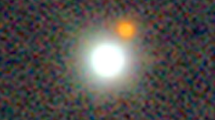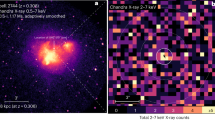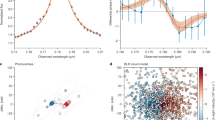Abstract
Quasars are the most luminous non-transient objects known and as a result they enable studies of the Universe at the earliest cosmic epochs. Despite extensive efforts, however, the quasar ULAS J1120 + 0641 at redshift z = 7.09 has remained the only one known at z > 7 for more than half a decade1. Here we report observations of the quasar ULAS J134208.10 + 092838.61 (hereafter J1342 + 0928) at redshift z = 7.54. This quasar has a bolometric luminosity of 4 × 1013 times the luminosity of the Sun and a black-hole mass of 8 × 108 solar masses. The existence of this supermassive black hole when the Universe was only 690 million years old—just five per cent of its current age—reinforces models of early black-hole growth that allow black holes with initial masses of more than about 104 solar masses2,3 or episodic hyper-Eddington accretion4,5. We see strong evidence of absorption of the spectrum of the quasar redwards of the Lyman α emission line (the Gunn–Peterson damping wing), as would be expected if a significant amount (more than 10 per cent) of the hydrogen in the intergalactic medium surrounding J1342 + 0928 is neutral. We derive such a significant fraction of neutral hydrogen, although the exact fraction depends on the modelling. However, even in our most conservative analysis we find a fraction of more than 0.33 (0.11) at 68 per cent (95 per cent) probability, indicating that we are probing well within the reionization epoch of the Universe.
This is a preview of subscription content, access via your institution
Access options
Access Nature and 54 other Nature Portfolio journals
Get Nature+, our best-value online-access subscription
$29.99 / 30 days
cancel any time
Subscribe to this journal
Receive 51 print issues and online access
$199.00 per year
only $3.90 per issue
Buy this article
- Purchase on Springer Link
- Instant access to full article PDF
Prices may be subject to local taxes which are calculated during checkout




Similar content being viewed by others
References
Mortlock, D. J. et al. A luminous quasar at a redshift of z = 7.085. Nature 474, 616–619 (2011)
Latif, M. A., Schleicher, D. R. G., Schmidt, W. & Niemeyer, J. Black hole formation in the early Universe. Mon. Not. R. Astron. Soc. 433, 1607–1618 (2013)
Alexander, T. & Natarajan, P. Rapid growth of seed black holes in the early Universe by supra-exponential accretion. Science 345, 1330–1333 (2014)
Pacucci, F., Volonteri, M. & Ferrara, A. The growth efficiency of high-redshift black holes. Mon. Not. R. Astron. Soc. 452, 1922–1933 (2015)
Inayoshi, K., Haiman, Z. & Ostriker, J. P. Hyper-Eddington accretion flows on to massive black holes. Mon. Not. R. Astron. Soc. 459, 3738–3755 (2016)
Wright, E. L. et al. The Wide-field Infrared Survey Explorer (WISE): mission description and initial on-orbit performance. Astron. J. 140, 1868–1881 (2010)
Lawrence, A. et al. The UKIRT Infrared Deep Sky Survey (UKIDSS). Mon. Not. R. Astron. Soc. 379, 1599–1617 (2007)
Bañados, E. et al. The Pan-STARRS1 distant z > 5.6 quasar survey: more than 100 quasars within the first Gyr of the Universe. Astrophys. J. Suppl. Ser. 227, 11 (2016)
Venemans, B. P. et al. Copious amounts of dust and gas in a z = 7.5 quasar host galaxy. Astrophys. J. 851, L8 (2017)
Venemans, B. P. et al. Bright [C ɪɪ] and dust emission in three z > 6.6 quasar host galaxies observed by ALMA. Astrophys. J. 816, 37 (2016)
Planck Collaboration. Planck 2015 results. XIII. Cosmological parameters. Astron. Astrophys. 594, A13 (2016)
Planck Collaboration. Planck intermediate results. XLVII. Planck constraints on reionization history. Astron. Astrophys. 596, A108 (2016)
Vestergaard, M. & Osmer, P. S. Mass functions of the active black holes in distant quasars from the Large Bright Quasar Survey, the Bright Quasar Survey, and the color-selected sample of the SDSS Fall Equatorial Stripe. Astrophys. J. 699, 800–816 (2009)
Mejía-Restrepo, J. E., Lira, P., Netzer, H., Trakhtenbrot, B. & Capellupo, D. M. The effect of nuclear gas distribution on the mass determination of supermassive black holes. Nat. Astron. https://doi.org/10.1038/s41550-017-0305-z (2017)
Richards, G. T. et al. Spectral energy distributions and multiwavelength selection of type 1 quasars. Astrophys. J. Suppl. Ser. 166, 470–497 (2006)
Wu, X.-B. et al. An ultraluminous quasar with a twelve-billion-solar-mass black hole at redshift 6.30. Nature 518, 512–515 (2015)
Becker, G. D. et al. Evidence of patchy hydrogen reionization from an extreme Lyα trough below redshift six. Mon. Not. R. Astron. Soc. 447, 3402–3419 (2015)
Miralda-Escudé, J. Reionization of the intergalactic medium and the damping wing of the Gunn–Peterson trough. Astrophys. J. 501, 15–22 (1998)
Greig, B., Mesinger, A., Haiman, Z. & Simcoe, R. A. Are we witnessing the epoch of reionization at z = 7.1 from the spectrum of J1120 + 0641? Mon. Not. R. Astron. Soc. 4239–4249 (2016)
Bosman, S. E. I. & Becker, G. D. Re-examining the case for neutral gas near the redshift 7 quasar ULAS J1120 + 0641. Mon. Not. R. Astron. Soc. 452, 1105–1111 (2015)
Simcoe, R. A. et al. Extremely metal-poor gas at a redshift of 7. Nature 492, 79–82 (2012)
Songaila, A. & Cowie, L. L. The evolution of Lyman limit absorption systems to redshift six. Astrophys. J. 721, 1448–1466 (2010)
Zheng, Z.-Y. et al. First results from the Lyman Alpha Galaxies in the Epoch of Reionization (LAGER) survey: cosmological reionization at z ~ 7. Astrophys. J. 842, L22 (2017)
Gallerani, S., Fan, X., Maiolino, R. & Pacucci, F. Physical properties of the first quasars. Publ. Astron. Soc. Aust. 34, e022 (2017)
Pâris, I. et al. The Sloan Digital Sky Survey quasar catalog: twelfth data release. Astron. Astrophys. 597, A79 (2017)
Fan, X. et al. Constraining the evolution of the ionizing background and the epoch of reionization with z ~ 6 quasars. II. A sample of 19 quasars. Astron. J. 132, 117–136 (2006)
Eilers, A.-C. et al. Implications of z ~ 6 quasar proximity zones for the epoch of reionization and quasar lifetimes. Astrophys. J. 840, 24 (2017)
Suzuki, N., Tytler, D., Kirkman, D., O’Meara, J. M. & Lubin, D. Predicting QSO continua in the Lyα forest. Astrophys. J. 618, 592–600 (2005)
Pâris, I. et al. A principal component analysis of quasar UV spectra at z ~ 3. Astron. Astrophys. 530, A50 (2011)
Alvarez, M. A. & Abel, T. Quasar H ɪɪ regions during cosmic reionization. Mon. Not. R. Astron. Soc. 380, L30–L34 (2007)
Davies, F., Furlanetto, S. & McQuinn, M. Quasar ionization from Lyα emission in an inhomogeneous intergalactic medium. Mon. Not. R. Astron. Soc. 457, 3006–3023 (2016)
Lukić, Z. et al. The Lyman α forest in optically thin hydrodynamical simulations. Mon. Not. R. Astron. Soc. 446, 3697–3724 (2015)
Mesinger, A., Furlanetto, S. & Cen, R. 21CMFAST: a fast, seminumerical simulation of the high-redshift 21-cm signal. Mon. Not. R. Astron. Soc. 411, 955–972 (2011)
Drovandi, C., Pettitt, A. & Lee, A. Bayesian indirect inference using a parametric auxiliary model. Stat. Sci. 30, 72–95 (2015)
Bolton, J. S. et al. How neutral is the intergalactic medium surrounding the redshift z = 7.085 quasar ULAS J1120 + 0641? Mon. Not. R. Astron. Soc. 416, L70–L74 (2011)
Foreman-Mackey, D., Hogg, D. W., Lang, D. & Goodman, J. emcee: the MCMC hammer. Publ. Astron. Soc. Pacif. 125, 306–312 (2013)
Telfer, R. C., Zheng, W., Kriss, G. A. & Davidsen, A. F. The rest-frame extreme-ultraviolet spectral properties of quasi-stellar objects. Astrophys. J. 565, 773–785 (2002)
Acknowledgements
We thank D. Ossip for support with the FIRE echellette observations and A. Stephens for help preparing the GNIRS observations. This work is based on data collected with the Magellan Baade telescope, the Gemini North telescope (programme GN-2017A-DD-4), the Large Binocular Telescope and the IRAM/NOEMA interferometer. We are grateful for the support provided by the staff of these observatories. We acknowledge the use of the UKIDSS, WISE and DECaLS surveys.
Author information
Authors and Affiliations
Contributions
E.B., R.D., X.F., E.P.F., C.M., H.-W.R., D.S., B.P.V., F. Walter, F. Wang and J.Y. discussed and planned the candidate selection and observing strategy, and analysed the data. E.B. selected the quasar and with D.S. obtained and analysed the discovery spectrum. R.A.S. provided the final FIRE data reduction. J.F.H. provided the final GNIRS data reduction. G.C.R. carried out the follow-up Fourstar observations for this quasar. D.D.K. reduced the follow-up Fourstar data. J.M.W., B.P.V. and F. Walter contributed to the observations and analysis of the IRAM/NOEMA data. The damping-wing analyses were carried out by E.B. (model A), F.B.D. and J.F.H. (model B), and R.A.S. and M.L.T. (model C). F.B.D. and J.F.H. performed the PCA continuum modelling. R.A.S. performed the analysis to find the characteristics of a single absorber that could cause the absorption profile of the quasar. E.B. led the team and prepared the manuscript. All co-authors discussed the results and provided input to the paper and data analysis.
Corresponding author
Ethics declarations
Competing interests
The authors declare no competing financial interests.
Additional information
Reviewer Information Nature thanks D. Mortlock and the other anonymous reviewer(s) for their contribution to the peer review of this work.
Publisher's note: Springer Nature remains neutral with regard to jurisdictional claims in published maps and institutional affiliations.
Extended data figures and tables
Extended Data Figure 1 Modelling the intrinsic emission from J1342 + 0928.
The red lines represent the continuum used in the main text, which was constructed by averaging SDSS DR12 quasars with similar C iv properties (equivalent widths and blueshifts) to those observed in J1342 + 0928 (see Fig. 3). The blue lines are 100 random draws of PCA-reconstructed intrinsic emission, as described in Methods. In both cases, the mean intrinsic spectrum is shown as a thick line. The vertical dashed line shows the Lyα wavelength. The PCA-reconstructed spectrum has stronger emission around the Lyα line than does the SDSS-matched reconstructed emission. The dotted line is the mean SDSS quasar from ref. 29, which has a much stronger Lyα line than that of any of our continuum models of J1342 + 0928.
Extended Data Figure 2 Damping-wing analysis with continuum 2 (PCA) and model B.
a, Same as Fig. 3b, but showing 100 realizations of PCA-predicted intrinsic emission (blue) and damping-wing model (green) draws from the posterior PDF of model B (see Methods for details). Model B masks absorption systems only redwards of the Lyα line (pale blue) because this model takes into account the internal absorption in the proximity zone, which explains the larger scatter bluewards of the Lyα line (dashed vertical line). b, The marginalized posterior PDF of  . The 50th percentile is
. The 50th percentile is  and the 16th–84th (2.5th–97.5th) percentile interval is 0.45–0.87 (0.22–0.98).
and the 16th–84th (2.5th–97.5th) percentile interval is 0.45–0.87 (0.22–0.98).
Extended Data Figure 3 The marginalized posterior PDF of  using continuum 1 (SDSS-matched).
using continuum 1 (SDSS-matched).
a, Model B. b, Model C. Model B applied to continuum 1 yields the most conservative distribution of our analyses. Even in this case, a significantly neutral Universe with  at the 2σ level is implied.
at the 2σ level is implied.
Rights and permissions
About this article
Cite this article
Bañados, E., Venemans, B., Mazzucchelli, C. et al. An 800-million-solar-mass black hole in a significantly neutral Universe at a redshift of 7.5. Nature 553, 473–476 (2018). https://doi.org/10.1038/nature25180
Received:
Accepted:
Published:
Issue Date:
DOI: https://doi.org/10.1038/nature25180
This article is cited by
-
The formation and cosmic evolution of dust in the early Universe: I. Dust sources
The Astronomy and Astrophysics Review (2024)
-
Evidence for heavy-seed origin of early supermassive black holes from a z ≈ 10 X-ray quasar
Nature Astronomy (2023)
-
Detection of stellar light from quasar host galaxies at redshifts above 6
Nature (2023)
-
Cosmology with the Laser Interferometer Space Antenna
Living Reviews in Relativity (2023)
-
Astrophysics with the Laser Interferometer Space Antenna
Living Reviews in Relativity (2023)
Comments
By submitting a comment you agree to abide by our Terms and Community Guidelines. If you find something abusive or that does not comply with our terms or guidelines please flag it as inappropriate.




 using continuum 1 (SDSS-matched).
using continuum 1 (SDSS-matched).